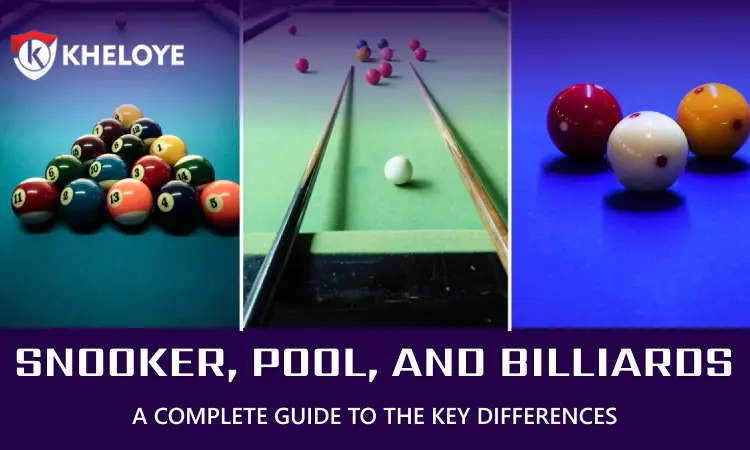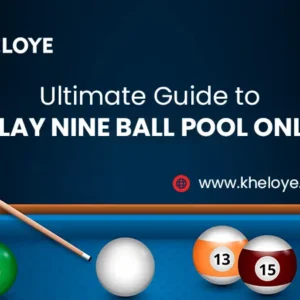Billiards and Pool are two terms that are frequently used synonymously. Non-professional players may find it simple to confuse these two table sports due to their similarities. However, despite their similarities, they also have unique characteristics that differentiate them.
Next, there is a snooker that further contributes to the mess.
All three of them—billiards, pool, and snooker—involve cue sticks, tables, and balls. However, what distinguishes these popular table sports? This blog post will help you to find the difference between these 9 ball pool games.
Before getting into the differences, let’s learn about them first:
What are snooker, pool, and billiards?
Snooker:
Snooker, like other cue sports, is played on a table with six pockets using cues. it is typically played with fifteen red balls, six colored balls, and one cue ball, all of which are notably larger than pool balls. this differs from billiards and pool in that it allows the use of three balls as a striker for hitting other balls, whereas in billiards and pool only the white cue ball can be used for hitting.
Pool:
The pool is a collection of cue sports that involve cue sticks and a table with six pockets placed along the rails for balls to be pocketed. In a typical game of pool, players use one black ball, seven yellow balls, seven red balls, and a white cue ball; but the number of balls can vary depending on the game.
Billiards:
Billiards, also known as carom billiards, is a cue sport played without pockets on table surfaces using cue sticks. Commonly, billiards typically involve three balls: a red ball, a white ball with a spot, and a plain white ball.

Billiards vs Pool vs Snooker
These games have 4 key differences:
Rules
Billiards: The primary objective in Carom 9 ball Billiards games is to earn points, known as “counts,” by rebounding the cue ball against the other two balls present on the playing surface. To decide who will begin the game, you need to pull a string, either based on an imaginary line (head string) or the number of wins (scoring string).
Pool: In Pool, players earn points by pocketing balls into the pockets of the table. Players decide in advance the target number of points required to win, typically one hundred for casual games and one hundred fifty for professional games. Each ball on the table is eligible to be pocketed, and the player earns one point for each successful pocketed ball.
Snooker: Snooker matches are organized into frames. The individual can secure a frame by obtaining the highest number of points by pocketing the red and colored balls using the cue ball. The red balls have a value of one point, the yellow two, the green three, the brown four, the blue five, the pink six, and the black seven.
During a particular round, the regulations dictate which ball is eligible to be put into a pocket. The balls labeled as “on” are the ones that can be put into a pocket during a particular turn.
Balls
Billiards, on the other hand, uses only three balls: white, yellow, and red, with the white and yellow balls serving as strikers. The balls are 2 7/16 inches in diameter.
In the pool, the number of balls in a complete set of pool balls varies depending on the type of game, but a complete set includes sixteen balls, each measuring 2 1/4 inches in diameter: eight solid colored balls numbered one through eight, seven colored-striped balls numbered nine through fifteen, and one solid white ‘cue’ ball.
Snooker is played using twenty-two balls, the white ball being the striker ball. A total of fifteen red balls were used, as well as yellow, brown, blue, pink, black, and green balls. Each ball is 2 1/16 inches in diameter.

Table
Pool Tables
- Size: The typical sizes are 7 feet, 8 feet, and 9 feet long.
- Pockets: Pool tables come equipped with six pockets, consisting of four corner pockets and two side pockets.
- Cushions: Pool tables’ cushions are intended to create a lively bounce to help enhance the speed of the game.
Snooker Tables
- Size: Typically measuring 12 feet by 6 feet as the standard size.
- Pockets: With six pockets, Snooker tables are narrower and more difficult to hit the ball into and require greater accuracy than other tables.
- Cushions: The cushions are created for a controlled and less lively bounce compared to pool tables.
Billiards Tables
- Size: Carom billiards tables are typically 10 feet by 5 feet.
- Pockets: Carom billiards tables are pocketless, as the game does not require pocketing balls but instead focuses on hitting object balls in a certain manner.
- Cushions: Carrom table cushions are specially made to ensure high accuracy and limited bounce, which is crucial for carrom shots.
Cue Sticks
Billiards Cues: Billiards cues are medium-weighted (500-600 gm) with a slight taper and a tip diameter usually between 11-12mm. This setup ensures both the power and accuracy needed for a carom shot on a table without a pocket.
Pool Cues: Pool cues are typically heavier (500-600 gm) and shorter (57-58 inches) than snooker cues, featuring a thicker shaft and bigger tip diameter (12.75-13.25mm). This structure offers the power and control needed to move around the bigger, heavier balls commonly used in games such as Eight-ball and Nine-ball in the pool.
Snooker Cues: Snooker cues have a weight of 430-510 grams, a length of 57-58 inches, a thinner shaft, and a smaller tip diameter of 9-10.5mm. This design allows for the precise handling of the cue ball with smaller snooker balls and the detailed positioning required in snooker, a game emphasizing strategy and skill.
Conclusion
Understanding the key differences between snooker, pool, and billiards enhances your gameplay. If you are playing snooker, pool, or billiards with strategy, each game offers a unique experience.
Now, you can enjoy these exciting 9-ball games online at Kheloye, the best online play-to-earn gaming platform. Play and test your skills while earning real money from the comfort of your home!


